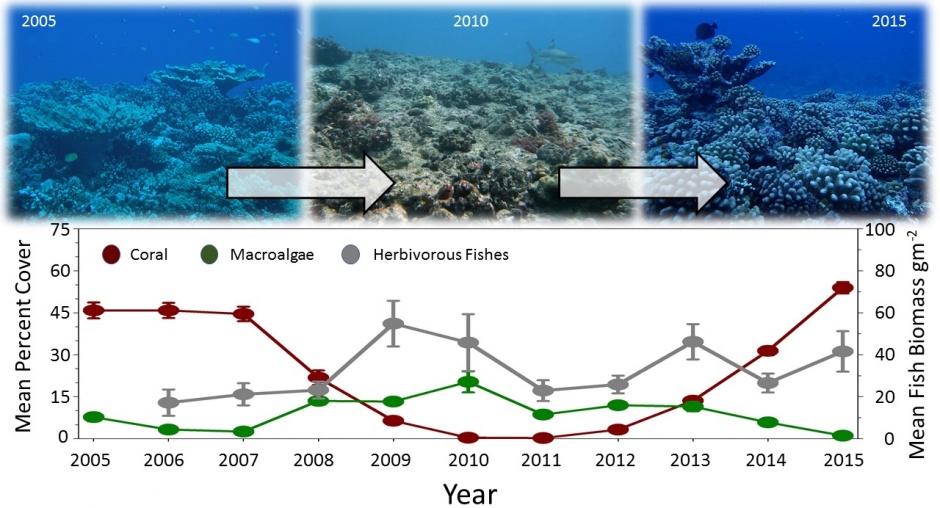
The documentation of long-term trends is designed to meet the needs for comparative analysis within the LTER system, to provide a contextual basis for process-oriented studies and provide parameter values for analytic models. Depending on the taxon or process under investigation, the scale and scope of our long-term time series program encompasses a variable number of sites, zones, depths, or frequencies of sampling.
The MCR Time Series program provides critical information on three key aspects of the ecosystem: community dynamics of major functional groups, rates of important ecosystem processes, and patterns of physical environmental processes.
Long-term trends of major functional groups
The abundance of corals, macro-invertebrates, algae and fishes are estimated yearly on the fore-reef, back-reef, and fringing reef at 6 sites, two on each side of Moorea. Estimates are made visually along band transects or from permanent quadrats that are either surveyed in situ (e.g., urchins, algae, fishes) or using photographs (e.g., corals). Supplementary sampling of corals and fishes occurs ever 2-3 years at additional sites to determine the degree to which core sampling is representative of broad island patterns.
Rates of important ecosystem processes
Rates of reef metabolism (primary production and respiration) are estimated twice annually along with photosynthetically active radiation (PAR) using a Lagrangian approach at two locations on the north shore of the island (sites 1 and 2) and every 3 years on the other shores (sites 3-6). Water column primary productivity is also estimated in vertical profiles using standard 14C tracer/bottle techniques in three habitats (fringing reef, back reef, and fore reef) on the north shore. Concentrations of nutrients are measured concurrently with water column primary productivity, bacterioplankton biomass, dissolved and particulate organic carbon (DOC and POC) concentrations, phaeo-pigments, Chl a and turbidity. Nutrient concentrations are also measured bi-weekly in the three habitats on the north shore. Since concentrations of nutrients in Moorea are typically low and near-detection limits, we estimate CHN in two macroalgae (Sargassum pacificum and Turbinaria ornata) as an integrated estimate of nutrient flux over longer periods.
Patterns of key physical factors
There are approximately 105 sensors located on the reefs around Moorea that measure abiotic conditions (water temperature, salinity, current speed/direction, offshore wave statistics [height, direction, period], and water levels). Time series data on regional scale properties such as currents, water mass variability and mesoscale eddies come from satellite remote sensing of sea surface topography (TOPEX Poseidon, ERS) and temperature (AVHRR, MODIS, VIIRS). Data from these in situ measurements and satellite data will be critical in assessing the future rates of local climate change and relationships to global climate patterns. Additionally, data relating to ocean acidification are collected via seawater samples and deployed SeaFET and SAMI pH sensors. Seawater samples are collected from a location 5 km offshore (to establish ambient background values of dissolved inorganic carbon [DIC] and pH).



